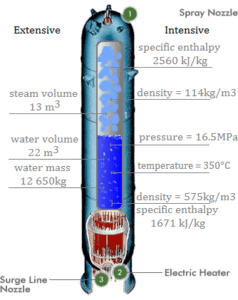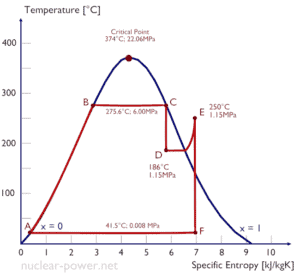Enthalpy Of Vaporization For Ethanol
The enthalpy of vaporization, (symbol ∆Hvap; unit: J) or heat of evaporation is the amount of free energy required to change stage from liquid to gas phase. Thermal Engineering
Enthalpy in Intensive Units – Specific Enthalpy

The enthalpy can be made into an intensive, or specific, variable by dividing by the mass. Engineers utilise the specific enthalpy in thermodynamic assay more than the enthalpy itself. The specific enthalpy (h) of a substance is its enthalpy per unit mass. It equals to the total enthalpy (H) divided past the full mass (m).
h = H/k
where:
h = specific enthalpy (J/kg)
H = enthalpy (J)
m = mass (kg)
Annotation that the enthalpy is the thermodynamic quantity equivalent to the total heat content of a system. The specific enthalpy is equal to the specific internal energy of the system plus the product of pressure and specific volume.
h = u + pv
In full general, enthalpy is a property of a substance, like pressure, temperature, and volume, but information technology cannot be measured straight. Usually, the enthalpy of a substance is given with respect to some reference value. For instance, the specific enthalpy of h2o or steam is given using the reference that the specific enthalpy of water is null at 0.01°C and normal atmospheric force per unit area, where hL = 0.00 kJ/kg. The fact that the absolute value of specific enthalpy is unknown is non a problem, however, because information technology is the change in specific enthalpy (∆h) and not the accented value that is of import in practical problems.
Meet also: Steam Tables
Energy Remainder in a Steam Generator

Calculate the amount of main coolant, which is required to evaporate 1 kg of feedwater in a typical steam generator. Assume that there are no free energy losses, this is only idealized example.
Residue of the chief excursion
The hot master coolant (water 330°C; 626°F; 16MPa) is pumped into the steam generator through primary inlet. The principal coolant leaves (water 295°C; 563°F; 16MPa) the steam generator through main outlet.
hI, inlet = 1516 kJ/kg
=> ΔhI = -206 kJ/kg
hI, outlet = 1310 kJ/kg
Balance of the feedwater
The feedwater (water 230°C; 446°F; half dozen,5MPa) is pumped into the steam generator through the feedwater inlet. The feedwater (secondary circuit) is heated from ~230°C 446°F to the humid point of that fluid (280°C; 536°F; 6,5MPa). Feedwater is then evaporated and the pressurized steam (saturated steam 280°C; 536°F; half-dozen,five MPa) leaves the steam generator through steam outlet and continues to the steam turbine.
hII, inlet = 991 kJ/kg
=> ΔhII = 1789 kJ/kg
hII, outlet = 2780 kJ/kg
Balance of the steam generator
Since the difference in specific enthalpies is less for primary coolant than for feedwater, information technology is obvious that the amount of principal coolant will be higher than 1kg. To produce of 1 kg of saturated steam from feedwater, about 1789/206 x i kg = 8.68 kg of primary coolant is required.
Enthalpy of Vaporization

In full general, when a material changes stage from solid to liquid, or from liquid to gas a certain amount of free energy is involved in this change of phase. In instance of liquid to gas phase change, this corporeality of energy is known as the enthalpy of vaporization, (symbol ∆Hvap; unit: J) also known equally the (latent) heat of vaporization or rut of evaporation. Latent heat is the amount of rut added to or removed from a substance to produce a modify in phase. This energy breaks down the intermolecular attractive forces, and also must provide the energy necessary to aggrandize the gas (the pΔV work). When latent heat is added, no temperature change occurs. The enthalpy of vaporization is a function of the pressure at which that transformation takes place.
Latent rut of vaporization – water at 0.1 MPa (atmospheric pressure)
hlg = 2257 kJ/kg
Latent heat of vaporization – h2o at 3 MPa (force per unit area inside a steam generator)
hlg = 1795 kJ/kg
Latent estrus of vaporization – water at 16 MPa (force per unit area inside a pressurizer)
hlg = 931 kJ/kg
The heat of vaporization diminishes with increasing force per unit area, while the boiling betoken increases. It vanishes completely at a certain indicate called the critical betoken. Higher up the critical point, the liquid and vapor phases are indistinguishable, and the substance is called a supercritical fluid.
The rut of vaporization is the heat required to completely vaporize a unit of measurement of saturated liquid (or condense a unit mass of saturated vapor) and information technology equal to hlg = hg − hl .
The heat that is necessary to melt (or freeze) a unit of measurement mass at the substance at abiding pressure is the heat of fusion and is equal to hsl = hl − hsouth , where hs is the enthalpy of saturated solid and hl is the enthalpy of saturated liquid.

Specific Enthalpy of Wet Steam
 The specific enthalpy of saturated liquid water (x=0) and dry steam (10=1) can be picked from steam tables. In case of wet steam, the actual enthalpy can be calculated with the vapor quality, 10, and the specific enthalpies of saturated liquid water and dry out steam:
The specific enthalpy of saturated liquid water (x=0) and dry steam (10=1) can be picked from steam tables. In case of wet steam, the actual enthalpy can be calculated with the vapor quality, 10, and the specific enthalpies of saturated liquid water and dry out steam:
h moisture = h south x + (i – x ) h fifty
where
h wet = enthalpy of wet steam (J/kg)
h due south = enthalpy of "dry" steam (J/kg)
h l = enthalpy of saturated liquid water (J/kg)
Equally can be seen, moisture steam volition always have lower enthalpy than dry out steam.
Example:

A loftier-pressure stage of steam turbine operates at steady state with inlet conditions of vi MPa, t = 275.6°C, x = 1 (betoken C). Steam leaves this phase of turbine at a pressure of 1.fifteen MPa, 186°C and x = 0.87 (point D). Calculate the enthalpy divergence between these 2 states.
The enthalpy for the country C can be picked directly from steam tables, whereas the enthalpy for the land D must be calculated using vapor quality:
h 1, wet = 2785 kJ/kg
h two, wet = h 2,southward 10 + (1 – x ) h 2,l = 2782 . 0.87 + (ane – 0.87) . 790 = 2420 + 103 = 2523 kJ/kg
Δh = 262 kJ/kg
References:
Reactor Physics and Thermal Hydraulics:
- J. R. Lamarsh, Introduction to Nuclear Reactor Theory, second ed., Addison-Wesley, Reading, MA (1983).
- J. R. Lamarsh, A. J. Baratta, Introduction to Nuclear Engineering science, 3d ed., Prentice-Hall, 2001, ISBN: 0-201-82498-1.
- Due west. G. Stacey, Nuclear Reactor Physics, John Wiley & Sons, 2001, ISBN: 0- 471-39127-i.
- Glasstone, Sesonske. Nuclear Reactor Engineering: Reactor Systems Engineering, Springer; quaternary edition, 1994, ISBN: 978-0412985317
- Todreas Neil E., Kazimi Mujid Southward. Nuclear Systems Book I: Thermal Hydraulic Fundamentals, Second Edition. CRC Printing; 2 edition, 2012, ISBN: 978-0415802871
- Zohuri B., McDaniel P. Thermodynamics in Nuclear Ability Plant Systems. Springer; 2015, ISBN: 978-iii-319-13419-2
- Moran Michal J., Shapiro Howard North. Fundamentals of Technology Thermodynamics, Fifth Edition, John Wiley & Sons, 2006, ISBN: 978-0-470-03037-0
- Kleinstreuer C. Mod Fluid Dynamics. Springer, 2010, ISBN 978-one-4020-8670-0.
- U.S. Section of Energy, THERMODYNAMICS, Estrus TRANSFER, AND FLUID Flow. DOE Fundamentals Handbook, Volume 1, 2 and 3. June 1992.
We hope, this article, Enthalpy of Vaporization, helps you. If so, give us a similar in the sidebar. Main purpose of this website is to help the public to learn some interesting and important information about thermal engineering.
Enthalpy Of Vaporization For Ethanol,
Source: https://www.thermal-engineering.org/what-is-enthalpy-of-vaporization-definition/
Posted by: bennettwasat1989.blogspot.com


0 Response to "Enthalpy Of Vaporization For Ethanol"
Post a Comment